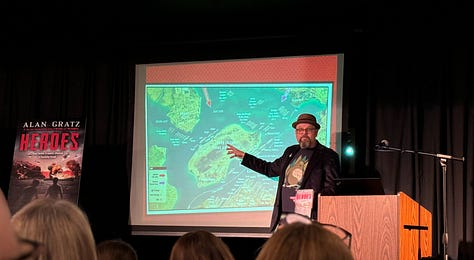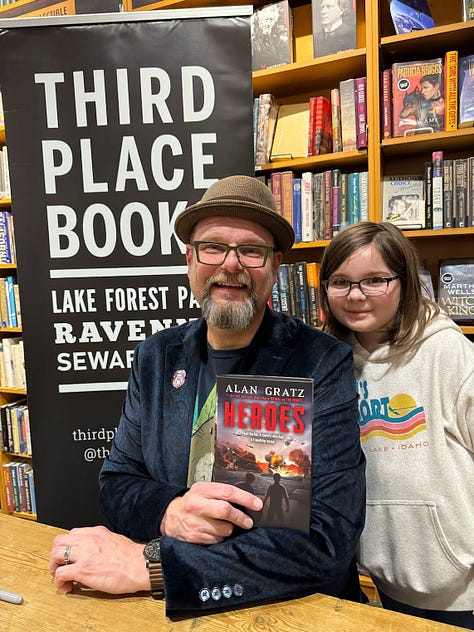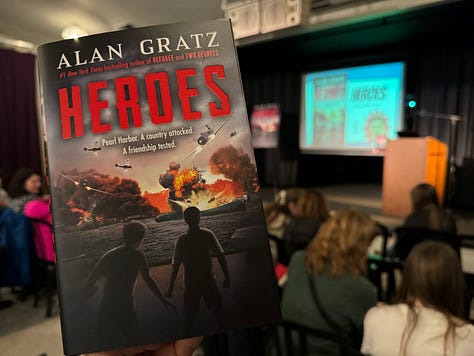A book to read: HEROES by Alan Gratz
A few days ago my kid and I went to Third Place Books to hear Alan Gratz talk about his new book. Alan is a (mostly) middle grade writer of historical fiction, but many of my high school students love his work too. One big tall junior still pops into my classroom to borrow Alan Gratz books even though he bashfully admits that he should have outgrown them by now.
Alan was fantastic. His presentation (like his book) opens with Superheroes. He talks about how great responsibility and great power go together in the superhero world, and then makes the connection to WWII. US allies were asking for help that we weren’t giving. Just like Spiderman, who didn’t dedicate himself to saving mankind until his own world was shattered, the US didn’t commit to helping our Allies until Pearl Harbor was attacked.
HEROES is about two friends who live on the base at Pearl Harbor on that fateful December day in 1941. Like all Alan Gratz novels, it’s completely absorbing page turner. The books is broken up into three parts:
BEFORE: This section is mostly about Frank, the main character. Frank is terrified of absolutely everything. Also, his best friend is Stanley, an American of Japanese Ancestry. The last three pages of this section are the beginning of the attack. The boys are on the Utah when the attack begins. As I was reading the book, it seemed to take an extraordinarily long time for everyone to realize that an attack and not random drills were happening. In reality, less than three pages are spent on this little blip in time. This is to say that Gratz is a master at pacing.
DURING: The attack on Pearl Harbor takes up the bulk of the book, and Gratz does a fabulous job combining fast-paced action sequences with some intense moments of character building. The moment when Frank wonders why there are so many bees out on the water only to realize they are bullets is especially poignant, as is the scene where Stanley’s mom is frantically burying her Japanese heirlooms as metal clips and bullets rained down on their backyard.
AFTER: This section focuses on racism and the distrust of Japanese Americans that followed the attack. There is a delightful surprise at the end of the book :)
Back to the author talk. Alan was fantastic, giving enough historical details to keep all the grown-up history buffs entertained, but explaining everything so his core demographic of 11 year old readers were still be captivated.



During the Q&A period, tons of kid hands went up for questions. There were young writers wanting to know about his process, and many devoted readers wanting to know about the fates of characters in his previous books. It was inspiring to see such a dedicated fan base of young kids and Alan answered every question with kindness and humor. (His tips for writers: read a lot, write a lot , and keep an idea journal).
When I asked my daughter if she wanted to wait in the 30+ minute signing line, she enthusiastically nodded. She was captivated by the author too, and has now officially joined his legion of young fans.
A place to explore: Lake Forest Park, Washington
As Alan was talking about the events of 1941, I daydreamed (evening-dreamed? The event was at 6pm on a school night) about the little town we were in and how it fared during WWII.
Lake Forest Park is a tiny residential city. It’s less than 4 square miles. Besides the bookstore, it’s biggest draw is Lake Washington, which stretches south for over 20 miles, dividing the area’s biggest cities: Seattle and Bellevue. The home of Bill Gates can be seen from the water.1
Since time immemorial, Lake Forest Park has been the land of the Tuobeda’bš. By 1903, the loggers and fishers had depleted the area of fish and new landowners pushed Native Americans out of the area.
By WWII, the “forest” part of the town’s name no longer made sense. Logging, which had begun in the areas in the late 1800s, had depleted the old-growth forest. At first, logs were moved downhill to the lake using skid roads. By 1901, logging railroads sped up the process. Today, Log Boom Park is my favorite place to launch not logs, but my paddle board. The old-growth forest is gone, but the town is still surrounded by trees. If I go paddle boarding in the early morning, fish jump all around me and Mount Rainier emerges and disappears behind wooded peninsulas.
Also by WWII, Lake Forest Park had a school. The first one-room schoolhouse was constructed in Lake Forest Park in 1912. By the end of WWII, the Shoreline School District was formed, with the Lake Forest Park School as one of the eight grade schools in the district. It’s still in operation today.
When Pearl Harbor was bombed, the town’s shopping center simply featured a wooden town sign and the Lake Forest Park Mercantile. The shopping center where Third Place Books is located didn’t open until 1964. Today, the wooden sign and the Mercantile are gone. But Third Place Books is there, so students and community members can gather in Commons by the bookstore and hear Alan Gratz talk about superheroes and WWII and standing up for what is right.
A lesson to teach: Authors are great teachers
I wish I could have taken all my students to listen to Alan Gratz2 Learning from authors is great because:
Learning from anyone other than your teacher is always more fun. Once, I brought in another teacher to talk to my kids about jury duty and they listened to him way more than they listen to me. It’s occurring to me now that perhaps this is a ME problem? I hope not.
Authors, especially those who’ve spent time researching their book, have tons of information and their job is to filter out all the boring stuff. This makes for exceptionally engaging presentations.
Authors provide proof that one can grow up to be an author! Almost every time I hear an author talk, they say something about how they loved writing when they were little but it never occurred to them that someone could actually make money writing books. I want my story-loving students to be inspired by real life authors!
While I couldn’t load up all 120 of my students for a 6pm field trip, and I don’t have grant funding to pay for an author visit, I can still bring a glimpse of Alan to my students through YouTube.
Anytime we read anything, I try to find a clip of the author discussing the book or why they wrote it. A few favorites are Jason Reynolds talking about why books are time capsules, John Green discussing Paper Towns and how “maps don’t show you were you will go in life, but they show you were you might go,” Tami Charles making Freedom soup for Good Morning Philadelphia, and Cynthia Leitich Smith’s video clips about the Muscogee Nation (of which she is an enrolled citizen) and how her high school memories show up in her books.
Connecting an actual author’s face to a book makes it more real and just might get kids more interested in reading.
However, writing this newsletter has gotten me thinking that I should stop being lazy and just write a grant to bring an author into my classroom. The moment I do, I’ll let you all know how it goes.
Lake Washington flows into Lake Union (that’s where the houseboat from Sleepless in Seattle is), then into the Fremont Cut (where the UW crew team made famous by the Boys in the Boat book/movie practiced), and then out to the Salish Sea (Puget Sound) and the Pacific. My favorite running path, Burke-Gilman trail, follows the lake.
I was gratified to hear that several kids were there at the encouragement of their teacher who was also in attendance.



Wonderful reflections. Your students are so lucky to have you! and I hope kids out here in East Asia are reading books like Gratz's.
Thanks, Jenna! I’m sorry I didn’t recognize you when you came through the line. I was so focused on signing books! I remember your daughter though. I hope she loves the book!